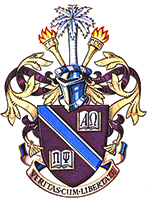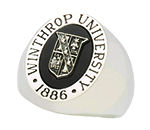 In 1899, Winthrop President David Bancroft Johnson appointed a faculty committee to
suggest a motto for the school. ˜Veritas cum Libertate,' or ˜Truth with Liberty,'
was chosen by the faculty. The committee then began designing a seal incorporating
the new motto as well as portions of the State of South Carolina seal. One image is
dominated by a tall Palmetto tree, which represents the battle fought on June 28,
1776 between defenders of the unfinished fort on Sullivan's Island, South Carolina
and the British Fleet. Banded together on the Palmetto with the motto "Quis separabit?"
(Who Will Separate [Us]?"), are 12 spears that represent the first 12 states of the
Union. The other image of the seal depicts a woman walking along a shore littered
with weapons. The woman, symbolizing Hope, grasps a branch of laurel as the sun rises
behind her. Below her image is the word "SPES," or "Hope." On May 14, 1900, the faculty
voted unanimously to accept the design still in use as the Winthrop seal.
In 1899, Winthrop President David Bancroft Johnson appointed a faculty committee to
suggest a motto for the school. ˜Veritas cum Libertate,' or ˜Truth with Liberty,'
was chosen by the faculty. The committee then began designing a seal incorporating
the new motto as well as portions of the State of South Carolina seal. One image is
dominated by a tall Palmetto tree, which represents the battle fought on June 28,
1776 between defenders of the unfinished fort on Sullivan's Island, South Carolina
and the British Fleet. Banded together on the Palmetto with the motto "Quis separabit?"
(Who Will Separate [Us]?"), are 12 spears that represent the first 12 states of the
Union. The other image of the seal depicts a woman walking along a shore littered
with weapons. The woman, symbolizing Hope, grasps a branch of laurel as the sun rises
behind her. Below her image is the word "SPES," or "Hope." On May 14, 1900, the faculty
voted unanimously to accept the design still in use as the Winthrop seal.
The Presidential medallion is symbolic of the authority vested in the office of president by the governing body of the University. Only the university president may wear it, and while wearing it, he speaks for the whole body of the institution. Winthrop's medallion is made of bronze and boasts the seal on the front.

The Winthrop University Coat of Arms, adopted in 1980, incorporates a shield and helm, and the University motto, "Veritas cum Libertate," which originally appeared on Winthrop's seal. A diagonal blue line through the shield represents the blue uniforms that were worn at Winthrop until the 1950s. The maroon and gold represent traditional school colors.
The first maces were weapon-like staffs used in ancient Rome to honor heroes and nobility. Maces later were used in the courts of England as symbols of authority. Today, maces are associated with the American judicial and legislative systems, as well as with colleges and universities. The Winthrop mace was designed, produced, and engraved by Alfred Ward, art and design professor emeritus. It is made of silver with detailing of 22K gold overlay. The stem is crafted from African hardwood.

The gonfalon, a flag that hangs from a crosspiece or frame, originated in the medieval republics of Italy as an ensign of state or office. Gonfalons have been adopted in many universities around the world as college or institutional insignias.
The four gonfalons used in formal University events represent the four academic colleges of Winthrop University: the College of Business and Technology, the Richard W. Riley College of Education, Sport, and Human Sciences, the College of Visual and Performing Arts, and the College of Arts and Sciences.
 Ring
RingThe official Winthrop University ring symbolizes pride and commitment and is a lasting memento of the wearer's Winthrop experience. The ring's design captures the University's distinctive traits and is presented in an oval shape. The design includes the crest portion of the university's seal and is framed at the top by the institution's name and its founding year at the bottom. Inside the ring, the University's motto is inscribed: "Veritas cum Liberate" or "Truth with Liberty." It is customary for the ring to be turned with the crest facing outward at the conclusion of the wearer's Commencement ceremony.